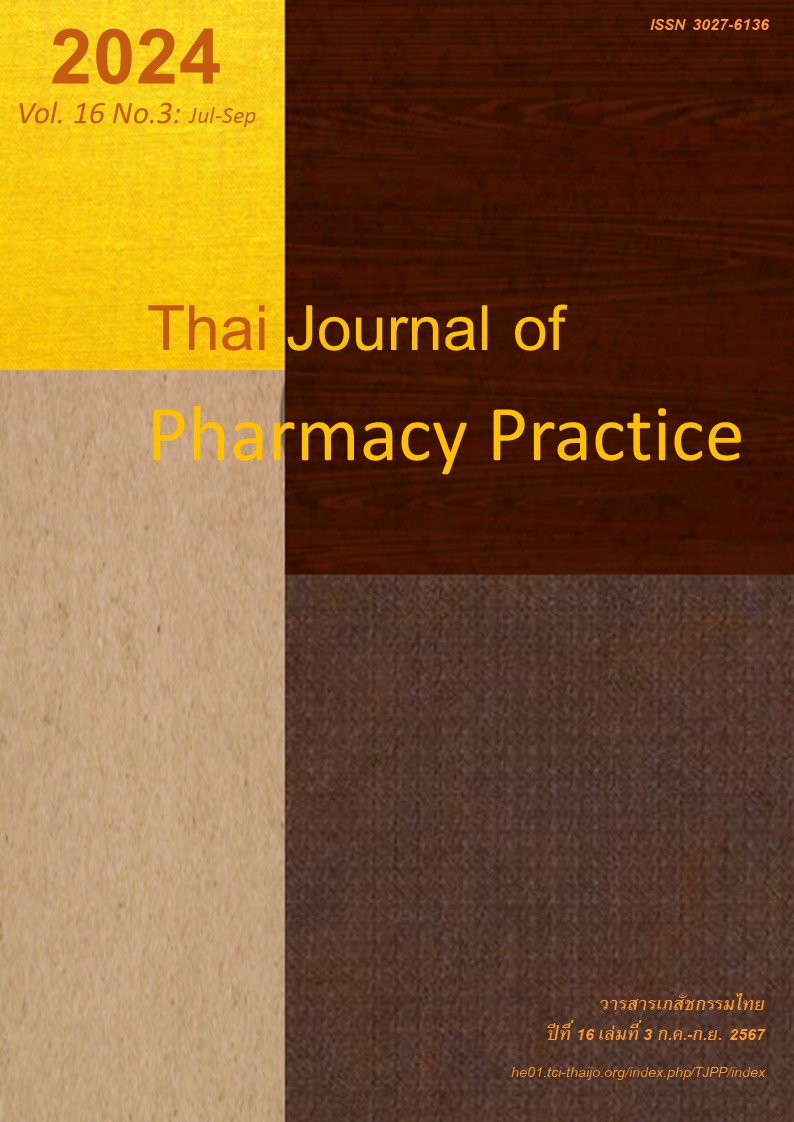ปัจจัยที่มีผลต่อคุณภาพการนอนหลับของผู้ป่วยที่ใช้น้ำมันกัญชาเพื่อ รักษาอาการนอนไม่หลับที่คลินิกกัญชาทางการแพทย์แผนไทย
Main Article Content
บทคัดย่อ
วัตถุประสงค์: เพื่อศึกษาคุณภาพการนอนหลับและปัจจัยที่มีผลต่อคุณภาพการนอนหลับของผู้ป่วยที่ใช้น้ำมันกัญชาเพื่อรักษาอาการนอนไม่หลับที่คลินิกกัญชาทางการแพทย์แผนไทย วิธีการ: รูปแบบวิจัยเป็นการศึกษาเชิงวิเคราะห์แบบตัดขวาง กลุ่มตัวอย่าง คือ ผู้ป่วย 279 คนที่ใช้น้ำมันกัญชาเพื่อรักษาอาการนอนไม่หลับที่คลินิกกัญชาทางการแพทย์แผนไทย ศูนย์ส่งเสริมสุขภาพแผนไทยฯ กรมการแพทย์แผนไทยและการแพทย์ทางเลือก การศึกษาวัดคุณภาพการนอนหลับโดยใช้แบบวัด Pittsburgh Sleep Quality Index ฉบับภาษาไทย ปัจจัยที่ศึกษาประกอบด้วย ข้อมูลทั่วไปของผู้ป่วยและความเครียดที่วัดด้วยแบบประเมินความเครียดสวนปรุง ผลการวิจัย: ตัวอย่างร้อยละ 53.0 มีคุณภาพการนอนหลับไม่ดี ร้อยละ 47.0 มีคุณภาพการนอนหลับดี ปัจจัยที่มีผลต่อคุณภาพการนอนหลับที่ไม่ดีอย่างมีนัยสำคัญทางสถิติที่ P <0.05 คือ ระดับการศึกษาปริญญาตรีหรือสูงกว่า (OR=1.93, 95%CI=1.19-3.12 เมื่อเทียบกับการศึกษาที่ต่ำกว่าปริญญาตรี) อาชีพลูกจ้าง/รับจ้าง ผู้ประกอบการ ค้าขาย และแม่บ้าน/พ่อบ้าน/ผู้เกษียณจากงาน (OR=4.64, 95%CI=1.58-13.61; OR=4.67, 95%CI=1.21-18.04; OR=7.40, 95%CI=2.34-23.38; OR=3.70, 95%CI=1.17-11.74 ตามลำดับ เมื่อเทียบกับข้าราชการ/ผู้ที่ทำงานในรัฐวิสาหกิจ) ผู้ที่ระบุเวลาทำงานแน่นอนไม่ได้และผู้ที่ทำงานมากกว่า 8 ชั่วโมงในหนึ่งวัน (OR=3.16, 95%CI=1.47-6.77; OR=2.99, 95%CI=1.45-6.14 ตามลำดับ เมื่อเทียบกับผู้ที่ทำงานน้อยกว่าหรือเท่ากับ 8 ชั่วโมงในหนึ่งวัน ผู้ที่มีโรคประจำตัว (OR=2.50, 95%CI=1.54-4.07) ผู้ที่มียาอื่นที่ใช้ประจำ (OR=2.27, 95%CI=1.39-3.72) ผู้ที่ใช้ยาที่มีฤทธิ์ทำให้ง่วงและเสริมการนอนหลับ (OR=11.47, 95%CI=1.47-89.47) ผู้ที่มีความเครียดปานกลางและสูง (OR=2.16, 95%CI=1.30-3.58 เมื่อเทียบกับผู้ที่มีความเครียดน้อย) และระยะเวลาในการใช้น้ำมันกัญชานาน 366-730 วันและมากกว่าหรือเท่ากับ 731 วัน (OR=1.85, 95%CI=1.14-3.10; OR=3.64, 95%CI=1.59-8.29 ตามลำดับ เมื่อเทียบกับผู้ที่ใช้น้ำมันกัญชาน้อยกว่าหรือเท่ากับ 365 วัน) สรุป: โรงพยาบาลสามารถนำปัจจัยที่พบว่ามีผลต่อคุณภาพการนอนหลับของผู้ป่วยที่ใช้น้ำมันกัญชามาดูแลผู้ป่วยที่คลินิกกัญชาทางการแพทย์แผนไทย
Article Details

อนุญาตภายใต้เงื่อนไข Creative Commons Attribution-NonCommercial-NoDerivatives 4.0 International License.
ผลการวิจัยและความคิดเห็นที่ปรากฏในบทความถือเป็นความคิดเห็นและอยู่ในความรับผิดชอบของผู้นิพนธ์ มิใช่ความเห็นหรือความรับผิดชอบของกองบรรณาธิการ หรือคณะเภสัชศาสตร์ มหาวิทยาลัยสงขลานครินทร์ ทั้งนี้ไม่รวมความผิดพลาดอันเกิดจากการพิมพ์ บทความที่ได้รับการเผยแพร่โดยวารสารเภสัชกรรมไทยถือเป็นสิทธิ์ของวารสารฯ
เอกสารอ้างอิง
Kitkawee P. Thai people "can't sleep" [online].2019 [cited Dec 10, 2022]. Available from: www.hfocus.org/ content/2019/03/16978.
Chaiarj S, Panya P. Insomnia and related factors. Thai Journal of Nursing Council 2005; 20: 1-12.
Na Wichian S. Sleep quality of older people in the community. Thai Journal of Nursing Council 2021; 36: 18-31.
Tipratchadaporn S, Srita J, Pomchaiya P, Boonyawan S, Silarak K. Benefit and safety of Suk Sai-yad traditional medicine recipe in patients with insomnia. Journal of Thai Traditional and Alternative Medicine, 2021; 19: 317-29.
MacCallum CA, Russo EB. Practical considerations in medical cannabis administration and dosing. Eur J Intern Med 2018; 49: 12-9.
Whiting PF, Wolff RF, Deshpande S, Di Nisio M, Duffy S, Hernandez AV, et al. Cannabinoids for medical use: a systematic review and meta-analysis. JAMA 2015; 313: 2456-73.
Health Administration Division. National overview report of C-MOPH program [online]. 2019 [cited Dec 9, 2021]. Available from: ccd.moph.go.th/report/web/.
Department of Thai Traditional and Alternative Medi- cine. Annual academic conference on Thai traditional medicine folk medicine and the 17th national alterna- tive medicine [online]. 2020 [cited Dec 9, 2021]. Available from: www.dtam.moph.go.th/E-Book/acade mic-meeting-172563/index.html#p=122.
Kessomboon P. Appropriate dosage of cannabis for the treatment of disease [online]. 2020 [cited Dec 9, 2021]. Available from: bit.ly/3uWtKSY.
Announcement of the National Drug System Deve- lopment Committee on national essential medicines list on herbs. 2564. Royal Gazette No. 139, Part 41 (Feb 18, 2022).
Faul F, Erdfelder E, Lang A-G, Buchner A. G*Power 3: A flexible statistical power analysis program for the social, behavioral, and biomedical sciences. Behav Res Methods 2007; 39: 175-91.
Suanprung Hospital. Suanprung Stress Test: SPST-20 [online]. 2019 [cited Dec 9, 2021]. Available from: e-learning.srru.ac.th/mod/resource/view.php?id=244 41.
Methipisit T, Mungthin M, Saengwanitch S, Ruang kana P, Chinwarun Y, Ruangkanchanasetr P, et al. The development of sleep questionnaires Thai version (ESS, SA-SDQ, and PSQI): linguistic valida- tion, reliability analysis and cut-off level to determine sleep related problems in Thai population. J Med Assoc Thai 2016; 99: 893-903.
Kaul M, Zee PC, Sahni AS. Effects of cannabinoids on sleep and their therapeutic potential for sleep disorders. Neurotherapeutics. 2021; 18: 217-27.
Lichstein KL, Taylor DJ, McCrae CS, Ruiter ME. Insomnia: Epidemiology and risk factors. In Principles and practice of sleep medicine: Fifth Edition. Elsevier Inc. 2010. p. 827-37 doi: 10.1016/B978-1-4160-6645-3.00076-1
Sivertsen B, Krokstad S, Overland S, Mykletun A. The epidemiology of insomnia: Associations with physical and mental health: The HUNT-2 study. J Psychosom Res 2009; 67: 109-16.
Kerdcharoen N, Wisitpongaree C, Padermpornrom yen C, Jaroennophakunsri C, Sittisak N, Imeuarbpa thom N, et al. Work factors related to sleep quality among professional nurses in the inpatient depart- ment. Vajira Medical Journal: Journal of Urban Medicine 2020: 64: 41-58.
Supamanee T, Kunaviktikul W, Keitlertnapha P. Nurses’ extended work hours and nurse outcomes in community hospitals. Nursing Journal 2014; 41 (supplement): 48-58.


